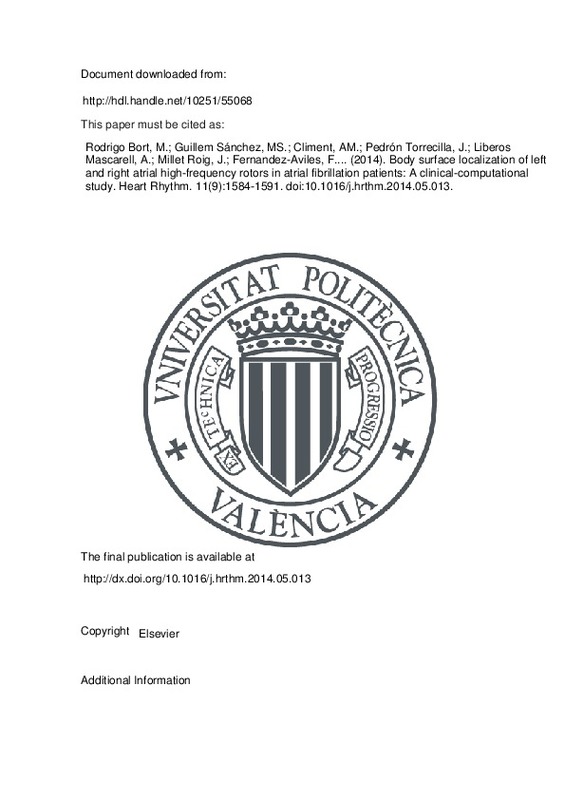JavaScript is disabled for your browser. Some features of this site may not work without it.
Buscar en RiuNet
Listar
Mi cuenta
Estadísticas
Ayuda RiuNet
Admin. UPV
Body surface localization of left and right atrial high-frequency rotors in atrial fibrillation patients: A clinical-computational study
Mostrar el registro sencillo del ítem
Ficheros en el ítem
| dc.contributor.author | Rodrigo Bort, Miguel
|
es_ES |
| dc.contributor.author | Guillem Sánchez, María Salud
|
es_ES |
| dc.contributor.author | Climent, Andreu M.
|
es_ES |
| dc.contributor.author | Pedrón Torrecilla, Jorge
|
es_ES |
| dc.contributor.author | Liberos Mascarell, Alejandro
|
es_ES |
| dc.contributor.author | Millet Roig, José
|
es_ES |
| dc.contributor.author | Fernandez-Aviles, Francisco
|
es_ES |
| dc.contributor.author | Atienza, Felipe
|
es_ES |
| dc.contributor.author | Berenfeld, Omer
|
es_ES |
| dc.date.accessioned | 2015-09-24T10:46:17Z | |
| dc.date.available | 2015-09-24T10:46:17Z | |
| dc.date.issued | 2014-09 | |
| dc.identifier.issn | 1547-5271 | |
| dc.identifier.uri | http://hdl.handle.net/10251/55068 | |
| dc.description.abstract | Background: Ablation is an effective therapy in atrial fibrillation (AF) patients in which an electrical driver can be identified. Objective: The aim of this study is to present and discuss a novel and strictly non-invasive approach to map and identify atrial regions responsible for AF perpetuation. Methods: Surface potential recordings of 14 patients with AF were recorded using a 67-lead recording system. Singularity points (SPs) were identified in surface phase maps after band-pass filtering at the highest dominant frequency (HDF). Mathematical models of combined atria and torso were constructed and used to investigate the ability of surface phase maps to estimate rotor activity in the atrial wall. Results: The simulations show that surface SPs originate at atrial SPs, but not all atrial SPs are reflected at the surface. Stable SPs were found in AF signals during 8.3±5.7% vs. 73.1±16.8% of the time in unfiltered vs. HDF-filtered patient data respectively (p<0.01). The average duration of each rotational pattern was also lower in unfiltered than in HDF-filtered AF signals (160±43 vs. 342±138 ms, p<0.01) resulting in 2.8±0.7 rotations per rotor. Band-pass filtering reduced the apparent meandering of surface HDF rotors by reducing the effect of the atrial electrical activity taking place at different frequencies. Torso surface SPs representing HDF rotors during AF were reflected at specific areas corresponding to the fastest atrial location. Conclusion: Phase analysis of surface potential signals after HDF-filtering during AF shows reentrant drivers localized to either the LA or RA, helping in localizing ablation targets | es_ES |
| dc.description.sponsorship | This work was supported in part by the Spanish Society of Cardiology (Becas Investigacion Clinica 2009); the Universitat Politecnica de Valencia through its research initiative program; the Generalitat Valenciana grant (ACIF/2013/021); the Ministerio de Economia y Competitividad, Rod RIC; the Centro Nacional de Investigaciones Cardiovasculares (proyecto CNIC-13); the Coulter Foundation from the Biomedical Engineering Department, University of Michigan; the Gelman Award from the Cardiovascular Division, University of Michigan; the National Heart, Lung, and Blood Institute grants (P01411.039707, P01-1111187226, and R01-11L118304); and the Leducq Foundation. Dr Femandez-Aviles served on the advisory board of Medtronic and has received research funding from St Jude Medical Spain. Dr Berenfeld has received research support from Medtronic and St Jude Medical; he is a colbunder and scientific officer of Rhythm Solutions. None of the companies disclosed financed the research described in this article. | en_EN |
| dc.language | Inglés | es_ES |
| dc.publisher | Elsevier | es_ES |
| dc.relation.ispartof | Heart Rhythm | es_ES |
| dc.rights | Reconocimiento - No comercial - Sin obra derivada (by-nc-nd) | es_ES |
| dc.subject | Atrial fibrillation | es_ES |
| dc.subject | Electrocardiography | es_ES |
| dc.subject | Mapping | es_ES |
| dc.subject | Atrial rotor | es_ES |
| dc.subject | Body surface potential mapping | es_ES |
| dc.subject.classification | TECNOLOGIA ELECTRONICA | es_ES |
| dc.title | Body surface localization of left and right atrial high-frequency rotors in atrial fibrillation patients: A clinical-computational study | es_ES |
| dc.type | Artículo | es_ES |
| dc.identifier.doi | 10.1016/j.hrthm.2014.05.013 | |
| dc.relation.projectID | info:eu-repo/grantAgreement/GVA//ACIF%2F2013%2F021/ | es_ES |
| dc.relation.projectID | info:eu-repo/grantAgreement/NIH//R0111L118304/ | es_ES |
| dc.relation.projectID | info:eu-repo/grantAgreement/NIH//P01411039707/ | es_ES |
| dc.relation.projectID | info:eu-repo/grantAgreement/NIH//P011111187226/ | es_ES |
| dc.rights.accessRights | Abierto | es_ES |
| dc.contributor.affiliation | Universitat Politècnica de València. Instituto Universitario de Aplicaciones de las Tecnologías de la Información - Institut Universitari d'Aplicacions de les Tecnologies de la Informació | es_ES |
| dc.contributor.affiliation | Universitat Politècnica de València. Departamento de Ingeniería Electrónica - Departament d'Enginyeria Electrònica | es_ES |
| dc.description.bibliographicCitation | Rodrigo Bort, M.; Guillem Sánchez, MS.; Climent, AM.; Pedrón Torrecilla, J.; Liberos Mascarell, A.; Millet Roig, J.; Fernandez-Aviles, F.... (2014). Body surface localization of left and right atrial high-frequency rotors in atrial fibrillation patients: A clinical-computational study. Heart Rhythm. 11(9):1584-1591. https://doi.org/10.1016/j.hrthm.2014.05.013 | es_ES |
| dc.description.accrualMethod | S | es_ES |
| dc.relation.publisherversion | http://dx.doi.org/10.1016/j.hrthm.2014.05.013 | es_ES |
| dc.description.upvformatpinicio | 1584 | es_ES |
| dc.description.upvformatpfin | 1591 | es_ES |
| dc.type.version | info:eu-repo/semantics/publishedVersion | es_ES |
| dc.description.volume | 11 | es_ES |
| dc.description.issue | 9 | es_ES |
| dc.relation.senia | 279555 | es_ES |
| dc.identifier.pmcid | PMC4292884 | en_EN |
| dc.contributor.funder | Generalitat Valenciana | es_ES |
| dc.contributor.funder | National Institutes of Health, EEUU | es_ES |
| dc.contributor.funder | Biomedical Engineering Department, University of Michigan | es_ES |
| dc.contributor.funder | St. Jude Medical | es_ES |
| dc.contributor.funder | Universitat Politècnica de València | es_ES |
| dc.contributor.funder | Sociedad Española de Cardiología | es_ES |
| dc.contributor.funder | Leducq Foundation | es_ES |
| dc.contributor.funder | University of Michigan | es_ES |
| dc.contributor.funder | Medtronic, Estados Unidos | es_ES |
| dc.contributor.funder | Centro Nacional de Investigaciones Cardiovasculares | es_ES |
| dc.contributor.funder | Ministerio de Economía y Competitividad |







![[Cerrado]](/themes/UPV/images/candado.png)

